ANSI UPDATE
NEW NORTH AMERICAN ACCESS EQUIPMENT ANSI STANDARDS
The updated ANSI and CSA standards have helped create a more globally aligned product range. There are certain design features that are new to North America, but have been present in other parts of the world for over a decade. It’s a learning experience for everyone within the product life cycle, so Skyjack condensed the information in a way that’s easy to learn.
Click here for a full list of downloadable resources.
What's in a name?
Mobile Elevating Work Platform (MEWP) will replace the previously used Aerial Work Platform (AWP).


Most MEWPs compliant with the A92.20 design standard will be equipped with a load sensing system. An alarm will sound or flash when overloaded and normal elevating functions will be disabled.
If overloaded, some customers may be quick to call your service team thinking there is an issue with the machine, but that would not be the case. All regular functions will be operational once the platform is under its maximum rated load.

The same MEWP may have different capabilities (e.g. number of persons, platform load capacity, maximum elevation) depending on whether or not it’s being used for indoor or outdoor work. Many ANSI A92.20 compliant machines will have a slight increase in weight. It’s important to have updated spec sheets for contractors, ensuring they have the correct floor loading and capacity information so they get the right equipment for the job.

The new mandate of 1.1m (43.5”) minimum railing height limits the ability of some scissor models to fit through standard door heights. This means OEMs will be making an increased number of units with folding rails as standard.
 Chains are no longer permitted for platform guardrails or access gates, and toe boards must be present at the platform access locations (gates) moving forward. This means chain entrances will be replaced by half-height, full-height, or saloon style gates as standard.
Chains are no longer permitted for platform guardrails or access gates, and toe boards must be present at the platform access locations (gates) moving forward. This means chain entrances will be replaced by half-height, full-height, or saloon style gates as standard.

You can expect to see foam-filled only (no air-filled tires) on the vast majority of A92.20 compliant RT scissors and RT booms.
 The A92.22 standards state that the owner shall ensure that the MEWP is registered with the manufacturer so that safety-related bulletins may be received from the manufacturer. Additionally, qualified and trained supervisors of MEWP operators are required to monitor the performance of the work of the operator.
The A92.22 standards state that the owner shall ensure that the MEWP is registered with the manufacturer so that safety-related bulletins may be received from the manufacturer. Additionally, qualified and trained supervisors of MEWP operators are required to monitor the performance of the work of the operator.
 Under the new ANSI training standard (A92.24), when requested, dealers must either offer operator training or advise where users can obtain operator training by a qualified person who is experienced with the particular classification of MEWP and knowledgeable regarding the laws, regulations, safe use practices, manufacturer’s requirements, and recognition and avoidance of hazards associated with MEWPs. The curriculum, training environment, testing, documentation and record retention must also meet the requirements of the A92.24 standard, and the training must be presented in a manner that the trainee can understand.
Under the new ANSI training standard (A92.24), when requested, dealers must either offer operator training or advise where users can obtain operator training by a qualified person who is experienced with the particular classification of MEWP and knowledgeable regarding the laws, regulations, safe use practices, manufacturer’s requirements, and recognition and avoidance of hazards associated with MEWPs. The curriculum, training environment, testing, documentation and record retention must also meet the requirements of the A92.24 standard, and the training must be presented in a manner that the trainee can understand.
 Most MEWPs compliant with the A92.20 design standard will be equipped with a load sensing system. An alarm will sound or flash when overloaded and normal elevating functions will be disabled.
Most MEWPs compliant with the A92.20 design standard will be equipped with a load sensing system. An alarm will sound or flash when overloaded and normal elevating functions will be disabled.
If you hear an alarm sound or flash, your MEWP may be overloaded. The MEWP’s capacity label(s) will show the maximum rated load. Remember: your weight, the weight of your tools, and any accessories will affect how much you can safely bring to height.

The same MEWP may have different capabilities (e.g. number of persons, platform load capacity, maximum elevation) depending on whether or not it’s being used for indoor or outdoor work. Many ANSI A92.20 compliant machines will have a slight increase in weight. It’s important to have updated spec sheets for contractors, ensuring they have the correct floor loading and capacity information so they get the right equipment for the job.
 The new mandate of 1.1m (43.5”) minimum railing height limits the ability of some scissor models to fit through standard door heights. This means OEMs will be making an increased number of units with folding rails as standard.
The new mandate of 1.1m (43.5”) minimum railing height limits the ability of some scissor models to fit through standard door heights. This means OEMs will be making an increased number of units with folding rails as standard.

Chains are no longer permitted for platform guardrails or access gates, and toe boards must be present at the platform access locations (gates) moving forward. This means chain entrances will be replaced by half-height, full-height, or saloon style gates as standard.

You can expect to see foam-filled only (no air-filled tires) on the vast majority of A92.20 compliant RT scissors and RT booms.

A risk assessment must now be performed, which includes: identifying the task(s) to be performed, proper MEWP selection, assessing the risk, developing control measures and identifying safe work procedures.
 Training is still mandatory across the board when operating a MEWP, however ANSI A92.24 stipulates that training must extend past the operators and include supervisors as well. MEWP supervisors (who monitor operator performance and supervise their work) are to be trained according to requirements from ANSI A92.24, including: awareness of the applicable MEWP rules, regulations and standards, potential hazards and methods for mitigating the risk, proper MEWP selection for the task, and knowledge of the manufacturer’s operation manuals.
Training is still mandatory across the board when operating a MEWP, however ANSI A92.24 stipulates that training must extend past the operators and include supervisors as well. MEWP supervisors (who monitor operator performance and supervise their work) are to be trained according to requirements from ANSI A92.24, including: awareness of the applicable MEWP rules, regulations and standards, potential hazards and methods for mitigating the risk, proper MEWP selection for the task, and knowledge of the manufacturer’s operation manuals.
Operators also now have a responsibility to provide any other platform occupants with the knowledge to work safely on the MEWP, and provide at least one occupant with knowledge to operate controls in an emergency (if operator cannot).




